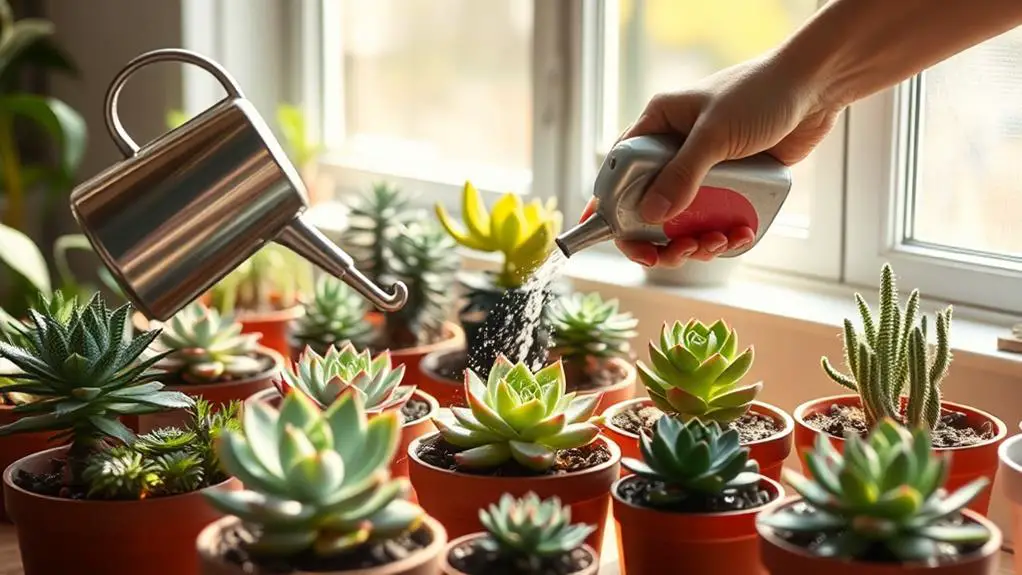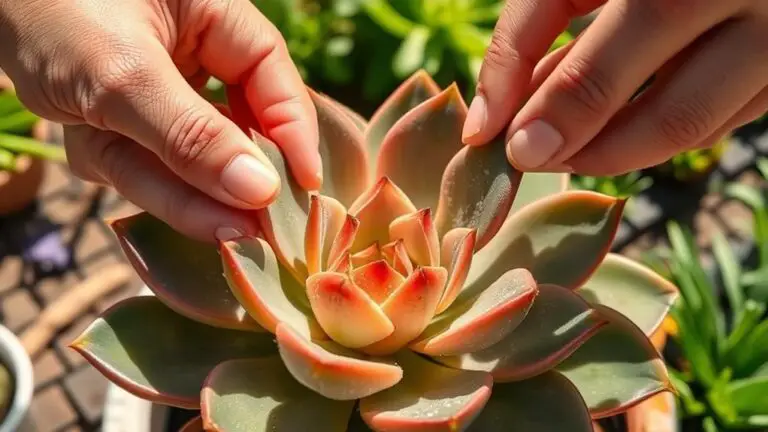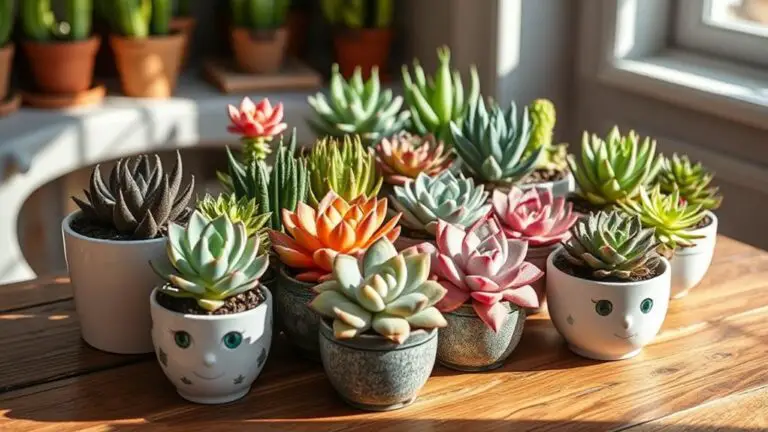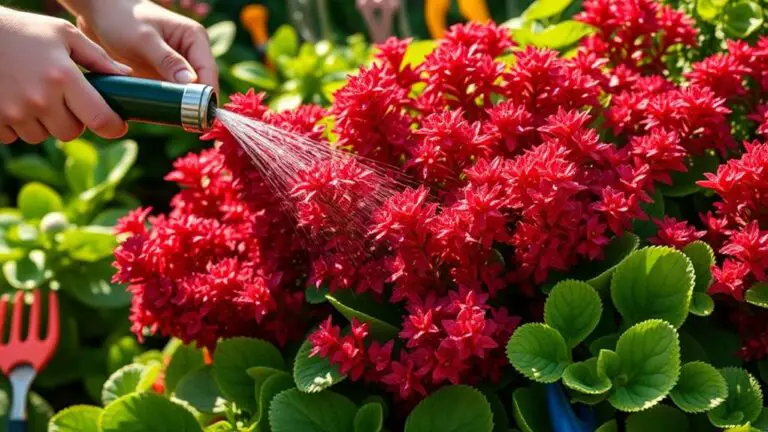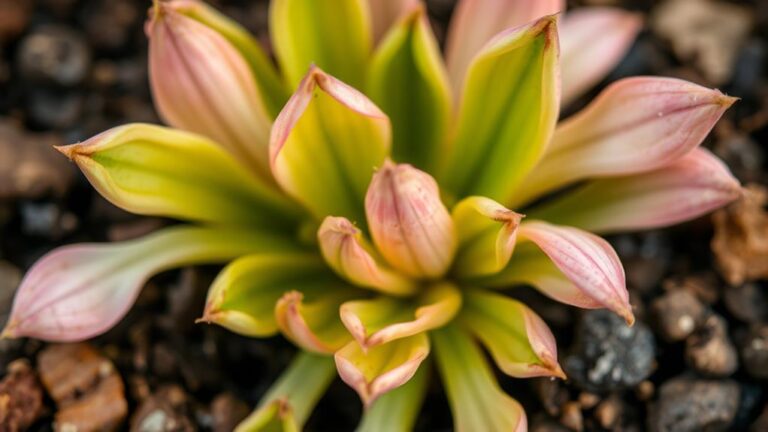Water Therapy for Succulents: Detailed Care Instructions
You've got a thirsty succulent, and traditional watering methods just aren't cutting it. Water therapy might be the solution you need to revive your plant. By submerging the roots in water, you can rapidly hydrate your succulent and stimulate new growth. But there's a fine line between effective hydration and potential root rot. So, how exactly do you perform this technique, and what should you watch out for afterward? Let's explore the detailed steps and essential aftercare practices to guarantee your succulent thrives.
What Is Water Therapy?
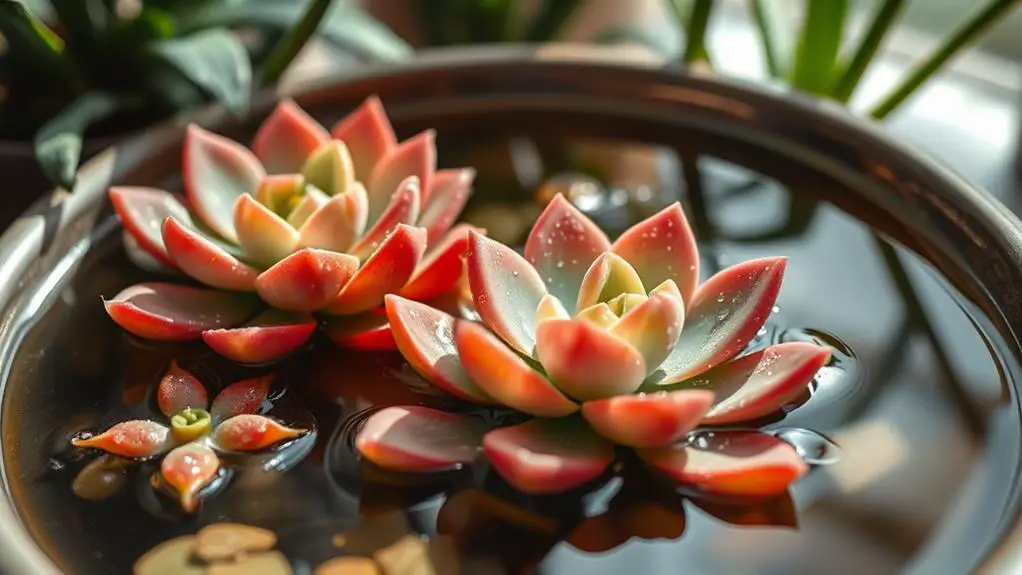
Water therapy is a lifesaver for severely under-watered succulents, especially when they're stressed out and in desperate need of hydration. This method involves submerging the roots of your succulents in water for a period of 24 to 72 hours, while the leaves and stems stay above the waterline. It's a simple yet effective way to help your plants rapidly absorb the water they need to bounce back.
To get started with water therapy, you'll need a container that allows the roots to be submerged but keeps the leaves and stems dry. Fill the container with enough water to cover the roots, then place your succulent in it.
Make sure to monitor the duration closely, as leaving the roots submerged for too long can lead to root rot or bruising.
Water therapy is especially useful for succulents that have endured shipping stress, severe dehydration, or too much sun exposure. However, it's not meant for plants with minor issues or those that are just slightly thirsty.
For those cases, regular watering and care methods will be more appropriate. By following these steps, you'll give your succulents the best chance to thrive and grow.
Benefits of Water Therapy
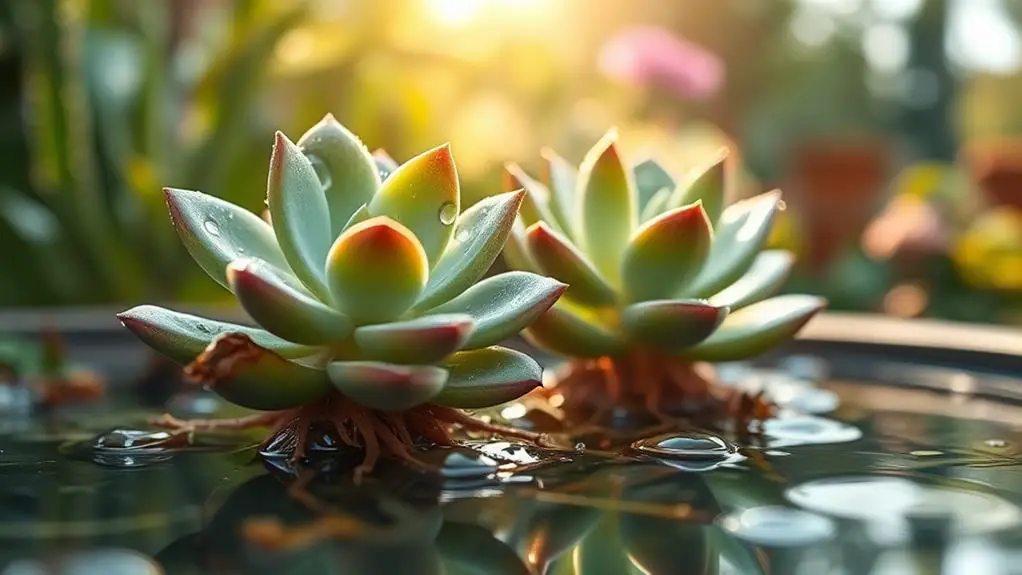
Although many plant care techniques exist, water therapy stands out due to its rapid hydration benefits for severely under-watered succulents. This method guarantees your plants recover quickly from dehydration stress.
Water therapy offers several key benefits:
- Rapid Hydration: Water therapy quickly rehydrates your succulents, making them bounce back from drought conditions faster than traditional watering methods.
- Stimulates Root Growth: By soaking the roots, water therapy promotes new root growth. This leads to stronger plants and healthier root systems.
- Improves Drought Tolerance: Succulents treated with water therapy develop better resilience. They become more capable of handling future droughts.
By using water therapy, your succulents can absorb moisture more efficiently, reducing the risk of root rot.
This technique encourages healthier root development, which in turn boosts nutrient absorption and supports vibrant foliage growth.
It's a temporary but effective solution that leads to improved resilience and overall health.
Risks and Drawbacks
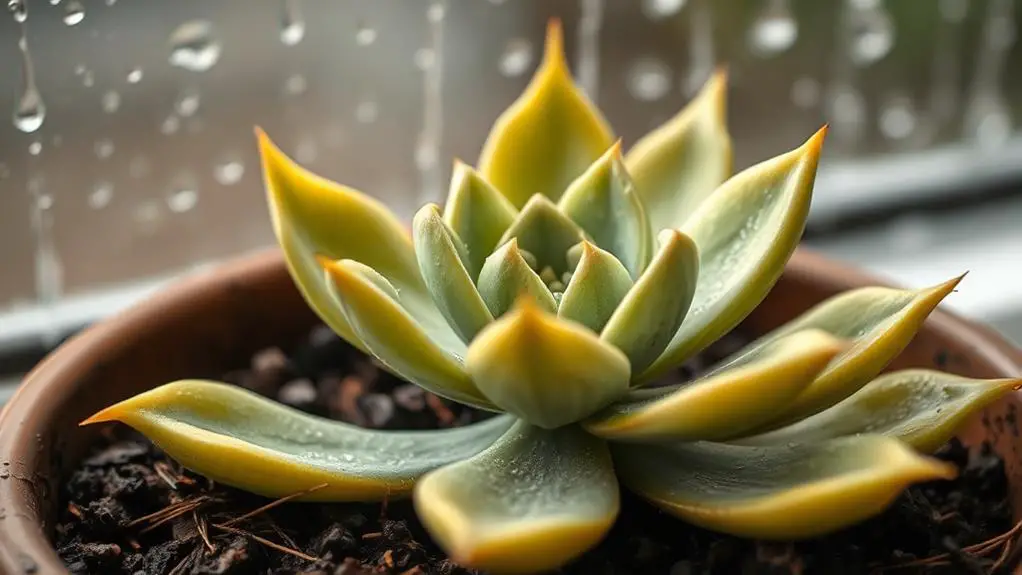
While water therapy can be a lifesaver for thirsty succulents, it's not without its risks and drawbacks. One major concern is root bruising or damage from frequent use, which can compromise your plant's overall health. Succulents are hardy, but their roots are delicate and can easily be harmed by too much handling.
Extended submersion times are another risk. If you leave the roots in water for too long, they might drown. This can lead to serious issues like root rot, which is often fatal for succulents.
When you're uprooting your plant for water therapy, it can stress the plant, making it harder for it to recover. Over-reliance on water therapy isn't good either. If you don't replant your succulent in proper soil with good drainage, it might develop root rot.
This condition is difficult to treat and can severely affect the plant's health.
When to Use Water Therapy

You should use water therapy when your succulents show signs of severe dehydration, like shriveled leaves or a wilted look, which means they haven't been watered for a long time.
It's also great for plants stressed from shipping or too much sun, as it quickly hydrates the roots.
After water therapy, make sure to let the plant dry out properly to avoid root rot and check for any signs of improvement.
Signs of Dehydration
When it comes to keeping succulents healthy, recognizing signs of dehydration is essential for timely intervention with water therapy. Dehydrated succulents can be saved if you know what to look for. Here are some key signs of dehydration that indicate your succulent may need water therapy:
- Shriveled Leaves: If you notice your succulent's leaves starting to shrivel, it means the plant is losing moisture and needs immediate care.
- Leaf Discoloration: Yellowing or browning leaves are a clear sign of dehydration. This change in color happens because the succulent isn't getting enough water.
- Lightweight Plant and Dry Soil: When the plant feels unusually light and the soil is bone dry, it's a good indicator that water therapy is needed.
Additionally, wrinkled textures on the leaves often mean the succulent is severely underwatered and can benefit from water therapy.
Another sign is stunted growth or a lack of new growth during the growing season. This suggests that the plant isn't receiving enough hydration.
Post-water Therapy Care
Post-water therapy care is essential for guaranteeing your succulent makes a full recovery and thrives. After you've had your succulent's roots in water for 24 to 72 hours, it's time to shift them back to their natural environment.
Start by gently removing the succulent from the water. Be careful not to damage the roots, as they can be delicate after soaking.
Next, you'll need to let the roots dry out for a few days. This step is vital to prevent root rot, which can occur if the roots remain too moist. Place your succulent in a shaded area with good air circulation. Avoid direct sunlight during this period, as it can stress the plant further.
Once the roots are dry, replant your succulent in well-draining soil. Make sure the pot has drainage holes to prevent water from pooling at the bottom.
Water the succulent lightly, allowing the soil to dry out completely between waterings. This helps the plant adjust and prevents it from becoming waterlogged.
Step-by-Step Instructions

The journey to revitalize your succulents with water therapy starts with gently removing the plant from its pot and cleaning the roots thoroughly to eliminate excess soil. This step is vital for ensuring that no clumps of soil hinder the water therapy process.
Next, follow these steps:
- Select a Container: Choose a container that comfortably fits the roots without overcrowding them. Fill it with rainwater or filtered water just below the lip for ideal submersion.
- Submerge the Roots: Place the roots of your succulent in the container. Keep the stem and leaves above the water surface to prevent rot. Let it soak for 24 to 72 hours, depending on the plant's condition.
- Monitor the Plant: During the soaking period, watch the succulent closely for signs of recovery. Look for new root growth or healthier leaf texture, which indicate the water therapy is working.
After soaking, let the roots dry completely for a few days. This drying period is essential to avoid rot when you replant the succulent in well-draining soil.
Monitoring and Aftercare

After finishing water therapy, keep a close eye on your succulent for any signs of stress like wilting or discoloration.
Let the roots dry for a few days before you replant it in proper soil, and avoid watering right away to reduce the risk of root rot.
Make sure the soil dries out completely between waterings and place your plant in bright, indirect light to help it recover and grow strong.
Check for Stress Indicators
Monitoring your succulent for stress indicators is crucial after water therapy to make certain it recovers effectively. Keep an eye out for these signs to verify your plant bounces back:
- Drooping Leaves: If your succulent's leaves start to droop, it might be stressed from overexposure to water. Check the roots for any signs of rot, such as a foul smell or a brown, mushy texture.
- Color Changes: Sudden changes in leaf color can indicate stress. If leaves turn yellow or brown, it could mean they absorbed water too quickly during therapy. Give your succulent time to acclimate and avoid direct sunlight until it's stable.
- Soft Spots and Leaf Edema: Soft spots or swollen, blistered leaves can occur due to rapid water absorption. These stress indicators suggest your plant needs a bit more time to adjust. Keep a close watch on soil moisture to prevent overwatering.
Monitoring the roots is essential. If you find anything suspicious, like an unpleasant smell or mushiness, your succulent may need immediate attention.
Gradually reintroduce it to indirect light and make certain the soil remains well-drained. Regularly inspect your plant and soil to maintain a healthy balance.
This careful attention helps your succulent thrive post-therapy, guaranteeing long-term health and growth.
Adjust Watering Frequency
To guarantee your succulent thrives post-water therapy, it's crucial to adjust the watering frequency based on its specific needs. After the water therapy, monitor your succulent closely. Look for signs like plump leaves or new growth to understand its hydration status.
When watering your succulents, always wait until the soil is completely dry. You can check this by using the finger test. Just insert your finger into the soil up to the second knuckle. If it feels dry, it's time to water. Remember, succulents generally need less water than other plants.
During the growing season, you might need to water every 1-3 weeks. In dormancy, usually in winter, this can extend to 4-6 weeks or longer. The frequency can vary greatly depending on factors like pot size, humidity, and light exposure. Smaller pots dry out faster, while larger pots retain moisture longer.
Keep an eye on your plant and adjust accordingly. If you notice the leaves becoming wrinkled, you may need to water more often. If they look soggy or mushy, you're likely overwatering. By tailoring your approach, you guarantee your succulent remains healthy and vibrant.
Replant With Proper Soil
Replanting succulents post-water therapy requires attention to detail and the right soil mix. The proper soil will guarantee your succulent thrives and avoids common issues like root rot. Follow these steps for a successful change:
- Choose a well-draining soil mix: Look for soil specifically designed for succulents. This type of soil prevents water retention, reducing the risk of root rot.
- Inspect the roots: Healthy roots should be vibrant and firm. Trim any damaged roots to help the plant recover. If the roots are mushy or dark, they need to be cut back to healthy tissue.
- Allow roots to dry: Before placing your succulent in the new soil, let the roots dry completely for a few hours. This helps reduce the risk of rot and encourages better integration into the new environment.
After replanting, it's essential to avoid watering for at least a week. This gives the roots time to adjust and heal without additional stress.
Monitor your succulent closely during the following weeks. Watch for signs of stress or new growth, and be ready to adjust your care practices based on how the plant responds.
With patience and proper care, your succulent will thrive after water therapy.
Alternative Hydration Methods

Exploring alternative hydration methods for succulents can dramatically improve their health and longevity.
One effective method is the 2-3-4 Method. This approach promotes better root growth by using a gritty mix and coconut coir. You follow a specific watering schedule: soak your succulent thoroughly, then let it dry for 2, 3, and 4 days alternately. This cycle guarantees the roots get enough water without becoming oversaturated.
Another useful technique is soaking the pot. By placing the entire pot in water for a set duration, moisture can deeply penetrate the soil, assuring the roots absorb what they need. This method avoids surface watering, which can lead to rot.
Drip irrigation is also excellent for succulents. It provides controlled, direct water delivery to the roots, minimizing waste and preventing leaf rot. You might find this method particularly handy if you have a busy schedule.
Bottom watering is another great choice. Place your pot in a shallow dish of water and let the soil absorb moisture from the bottom. This guarantees even water distribution and reduces the risk of damaging the leaves.
General Succulent Care Tips

While alternative hydration methods like the 2-3-4 Method and bottom watering can greatly enhance your succulent's well-being, there are general care tips that are equally important.
Caring for succulents isn't complicated if you follow some basic guidelines. Here are three critical aspects to take into account:
- Soil: Choose well-draining soil specifically formulated for succulents. This type of soil helps prevent root rot by allowing excess water to escape quickly after watering.
- Sun: Succulents love bright, indirect light. Place them near a sunny window but avoid too much direct sunlight, which can cause sunburn. Lack of light, on the other hand, can stunt their growth.
- Overwatering: One of the biggest mistakes is overwatering. Allow the soil to completely dry out between watering sessions. During dormant periods, usually in colder months, reduce watering frequency considerably.
Look out for signs of overwatering such as yellowing leaves, a mushy texture, and foul odors from the soil.
Frequently Asked Questions
What Are the Watering Instructions for Succulents?
Water your succulents deeply until it drains from the pot's holes, then let the soil completely dry out before watering again. During dormant periods, reduce watering. Always check soil moisture first and avoid standing water in pots.
How Do You Save a Severely Overwatered Succulent?
Remove the succulent from its pot and rinse off soggy soil. Trim any brown or mushy roots, then let the roots dry for a few hours to days. Replant in fresh soil, place in indirect light, and avoid watering.
How Long to Submerge a Succulent in Water?
You should submerge a succulent's roots in water for 24 to 72 hours, depending on its dehydration level. Keep an eye on it to avoid root rot, and make sure only the roots are underwater, not the leaves.
How Do You Rehab Succulents?
First, assess your succulent's health to identify dehydration, sunburn, or root rot. Use water therapy for severe dehydration. Submerge roots for 24-72 hours, then dry completely. Replant in well-draining soil and monitor closely for stress signs.
Conclusion
You've got this! Water therapy can be a game-changer for your dehydrated succulents. By following these steps and keeping a close eye on your plants, you'll help them bounce back stronger than ever. Remember, patience is key. After their water bath, give them time to adjust in well-draining soil and indirect light. Your care and attention will make all the difference. Happy gardening, and enjoy watching your succulents thrive!

